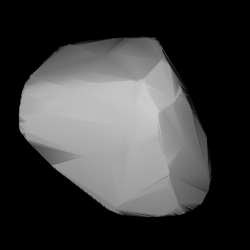 3D convex shape model of 104 Klymene | |
| Discovery | |
|---|---|
| Discovered by | James Craig Watson |
| Discovery date | 13 September 1868 |
| Designations | |
| (104) Klymene | |
| Pronunciation | /ˈklɪmɪniː/[1] |
| A868 RB, 1893 FA 1951 OE, 1968 OS[2] | |
| Main belt | |
| Orbital characteristics[3] | |
| Epoch 31 July 2016 (JD 2457600.5) | |
| Uncertainty parameter 0 | |
| Observation arc | 130.58 yr (47693 d) |
| Aphelion | 3.6499 AU (546.02 Gm) |
| Perihelion | 2.65525 AU (397.220 Gm) |
| 3.15256 AU (471.616 Gm) | |
| Eccentricity | 0.15775 |
| 5.60 yr (2044.5 d) | |
Average orbital speed | 16.67 km/s |
| 101.498° | |
| 0° 10m 33.888s / day | |
| Inclination | 2.7905° |
| 41.698° | |
| 32.134° | |
| Earth MOID | 1.66901 AU (249.680 Gm) |
| Jupiter MOID | 1.63907 AU (245.201 Gm) |
| TJupiter | 3.186 |
| Physical characteristics | |
| Dimensions | 163 km × 103 km (± 3 km × 5 km)[4] |
| 136.553±1.554 km[3] 133 km[4] | |
| Mass | (1.835 ± 0.880/0.495)×1018 kg[5] |
Mean density | 1.633 ± 0.783/0.441 g/cm3[5][a] |
Equatorial surface gravity | 0.0263 m/s2 |
Equatorial escape velocity | 0.0599 km/s |
| 8.984 h (0.3743 d)[3] | |
| 0.052±0.006[3] | |
| Temperature | ~157 K |
| C | |
| 8.58[3] | |
104 Klymene is a large, dark Themistian asteroid that was discovered by J. C. Watson on September 13, 1868, and named after one of the many Clymenes in Greek mythology.[6] It is orbiting the Sun with a period of 5.60 years and an eccentricity of 0.16. The orbital plane is inclined by 2.8° to the plane of the ecliptic. It is classified as a C-type asteroid, indicating it probably has a carbonaceous composition. The spectra indicates the presence of aqueous-altered minerals on the surface[7] based upon a sharp feature at a wavelength of 3 μm, and, as of 2015, is the only member of the Themis family found to show this absorption.[8]
Based upon measurements made using adaptive optics at the W. M. Keck Observatory, this object may have a bi-lobed shape with a length of 163 ± 3 km and width of 103 ± 5 km, for an average dimension of 133 km.[4] This asteroid is located near the region of the Themis family but itself considered a background asteroid using HCM-analysis.[9] It is listed as a member of the Hecuba group of asteroids that orbit near the 2:1 mean-motion resonance with Jupiter.[10]
104 Klymene has been observed to occult 6 stars between 2009 and 2023.
- ^ Noah Webster (1884) A Practical Dictionary of the English Language
- ^ Cite error: The named reference
Bowen1893was invoked but never defined (see the help page). - ^ a b c d e Cite error: The named reference
JPLwas invoked but never defined (see the help page). - ^ a b c Cite error: The named reference
Marchis2006was invoked but never defined (see the help page). - ^ a b Cite error: The named reference
FiengaEtAl2020was invoked but never defined (see the help page). - ^ Dictionary of minor planet names, International Astronomical Union. Springer, 2003, p. 25
- ^ Cite error: The named reference
Fornasier1999was invoked but never defined (see the help page). - ^ Cite error: The named reference
Hargrove2015was invoked but never defined (see the help page). - ^ Cite error: The named reference
Moore2011was invoked but never defined (see the help page). - ^ Cite error: The named reference
McDonald1948was invoked but never defined (see the help page).
Cite error: There are <ref group=lower-alpha> tags or {{efn}} templates on this page, but the references will not show without a {{reflist|group=lower-alpha}} template or {{notelist}} template (see the help page).